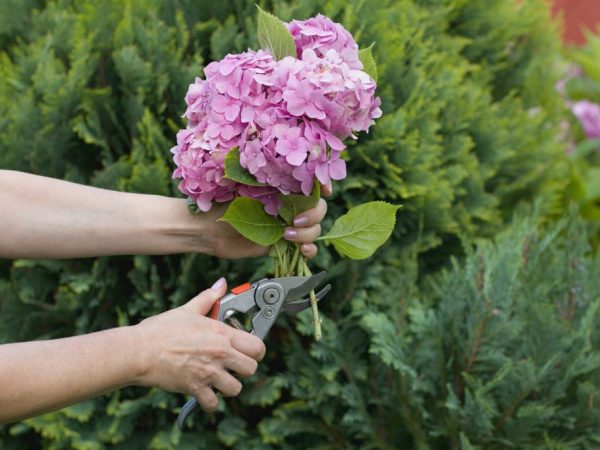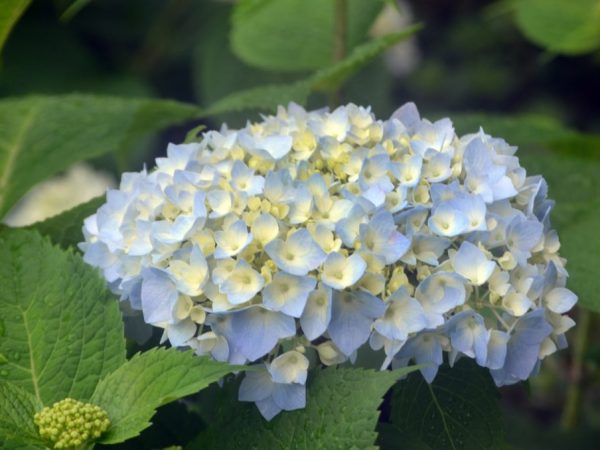Pruning and feeding hydrangeas in the fall
Caring for a hydrangea in the fall has a huge effect on its flowering next year, so it is worth approaching this process responsibly. Although it is an unpretentious flower, it requires care and attention.

Pruning and feeding hydrangeas in the fall
Autumn care
Stages of autumn care:
- It is necessary to carry out mulching. A good option for mulch would be such organic mixtures: compost, peat, manure, humus. A layer of 5 cm or more will not allow the soil to freeze, protect the roots and, decomposing, provide the flower with useful substances.
- Flowers especially need these procedures after pruning, the plant should have time to recover by winter. Fertilize better with mineral mixtures. Autumn feeding of garden hydrangeas does not include nitrogen, which is added to fertilizers in spring, because it stimulates the growth of shoots, and new branches do not have time to mature enough in the cold.
- Depending on the natural acidity of the soil, it is worth adding lime or natural materials. Limestone increases it, while sulfur, sawdust and pine bark lower it. The wrong percentage of acidity can make Blue Hydrangea Purple (Pink) - it changes color strongly depending on the acidity of the soil.
In autumn, loosening of the earth in the area of the trunk circle is also necessary. Loosen the soil to a depth of 10-12 cm, at least 3 times a month in the first week of each month.
Watering
Hydrangea is moisture-loving, so you need to carefully monitor the condition of the soil. Depending on the weather and precipitation, it is watered 1-2 times a week. If the trunk circle is mulched, then it costs a little less often. The acidity of the water should not exceed 5.6 pH, and it cannot pollute the earth with calcium.
Wintering
Indoor hydrangea in the fall does not need such preparation for winter as a flower in the country or in an outdoor garden.
It is required to prepare the plant - gradually stop watering a couple of weeks before the cold snap, feed and care for the hydrangea according to the autumn method from the beginning of the season.
Large-leaved hydrangea in early autumn requires special preparation for wintering. Paniculate varieties like Vanilla Freise or Weems Red and tree varieties like Annabelle or Grandiflora can hold up with mulch alone.
Caring for hydrangea paniculata in autumn can include several basic shelter methods:
- The simplest (but also the least effective) is the leaves. To create such a roof, the branches are fixed closer to the ground with ropes or wire pins, sprinkled with foliage, covered with any cloth and fastened with stones or stakes.
- Repeat the first method, but use spruce branches instead of foliage and cover the soil under the branches with it.
- The most reliable option would be to create a full-fledged frame with fiberboard, or made from wire - it did not bend strong enough. It is also worth sprinkling the base of the bush with dry earth and covering the frame with a waterproof material, leaving holes for ventilation. After the first snowfalls, they close.
- Small plants can be covered with peat and covered with foil.
- You can also repeat the first or second method, but cover them on top with a sheet of old iron instead of a simple cloth.
Pruning
Pruning your hydrangea is an important part of caring for your hydrangea to keep in mind. This not only preserves its decorative effect, the beauty of the silhouette and the splendor of the crown, but also promotes flowering and maintains the health of the plant. You need to know exactly when and how to do it.
First, a plant variety is selected. This will help determine the technique and degree of trimming the flower. It will also tell you a more favorable time for cutting - early spring or late autumn.
The recommended time for pruning in the fall is October, because it is then that sap flow slows down in the flower. This is precisely the main advantage of autumn pruning over spring pruning - the problem of juice leakage is eliminated. It is also worth adjusting the period depending on the type of flower - the tree hydrangea develops new branches more slowly, so it is better to hurry up with pruning, a later time is suitable for paniculate.

Pruning promotes lush flowering
The classic pruning technique is suitable for almost all species of this plant. It includes:
- cutting off the growth of up to 3-4 eyes;
- "Sanitary" part: removal of diseased, dry, frozen branches and shoots;
- Formation: arresting zero shoots that are not useful but over-compact the bush;
- Pruning the oldest, lowest shoots that produce the weakest growth.
An exception is the ground cover and large-leaved variety and young flowers. For groundcover hydrangeas, only sanitary pruning and shortening of long branches are performed. For seedlings under 3 years old and large-leaved hydrangea, only sanitary pruning is carried out, although sometimes even upper dry branches are left for them for additional protection from the cold before winter.
Also in the fall, radical pruning is carried out for old, neglected or affected by diseases and pests of garden hydrangeas. Such large flowers are cut using the classical technique and shortened to 50-80 cm. After dramatic changes, the plant will miss one flowering season, but will regain its attractive shape and its condition will improve for the next years.
Top dressing
You can feed the hydrangea in the fall in the first decade of September. A mixture of phosphate fertilizer and potassium is perfect, because potassium helps to strengthen the root system.
Timely feeding of hydrangeas in the early fall will provide the plant with good resistance to diseases and negative weather conditions, and prepare it for winter.
Transplant in the fall
In autumn, in September, planting or transplanting of a garden hydrangea is often carried out. It is better to plan a large-leaved transplant in the spring, but for tree-like and paniculate plants, autumn will be just as favorable, especially in warm climates.
Prepare for planting or transplanting in the spring. To do this, a trench is dug around the base of the flower, filled with compost and watered. When the time comes, the plant is dug on the outside of the trench, removed and planted in a pre-prepared hole with a nutrient mixture. The transplanted flower is fertilized and hides very well for the winter, the radical pruning described above is carried out, but after the transplant itself. Proper autumn care for decorative hydrangea includes full watering with a warm solution with a nutrient mixture until the very first frost.
Propagation of hydrangea in autumn
In August-September, you can increase your collection of flowers in the garden. It is optimal to propagate the hydrangea at this time by layering or dividing.
- In the spring, loosen the ground around the selected bush and make small depressions in the soil, lay side shoots in them, sprinkle with earth and water every day. In early to mid-autumn, the seedlings should reach about 0.5 m, then they need to be dug out and the shoots are separated from each other.
- Dividing a bush requires first watering it abundantly, pulling it out of the ground and rinsing the roots. Already divided parts are planted in individual places in the ground. This is the easiest way, but when using it, the gardener must be careful with the root system so as not to damage it.
If this is a decorative panicle hydrangea, care in the fall should be especially careful, because the flower is very fragile and extremely picky about soil and heat.
Disease prevention
It is necessary to take care of the hydrangea in the fall while simultaneously applying preventive measures against diseases and pests that threaten the flower. For this, preventive treatment of the bark and soil of the trunk circle is carried out. This is done after the first leaf falls. There are many suitable drugs for this, for example, Topaz, Iskra, Fitosporin.
The most common problems in the care of this flower are chlorosis, rust and insects. In order to avoid their appearance, it is required to monitor the percentage of acidity in the soil, do not fill in and do not forget about watering the plant.
Conclusion
Every gardener should know what to do with hydrangea in the fall, how to care for such a flower, at what time to fertilize, what is the best fertilization and how is the preparation for winter going. Subject to all the rules, the flower will be beautiful and healthy.


